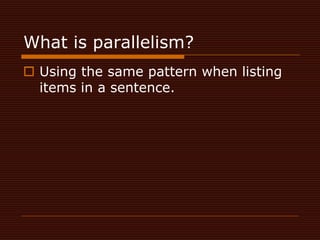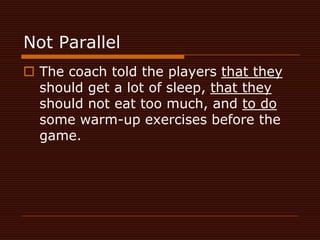Parallelism
- 2. What is Parallelism? âĒ Using the same pattern when listing items in a sentence.
- 3. Examples âĒ Some examples: â Jem enjoyed playing football and exploring the neighborhood. âĒ All consist of ---ing and a noun â Scout liked to swim, to read and to play. âĒ All consist of infinitives (to verbs) â The judge wrote his report quickly, accurately, and thoroughly. âĒ All consist of adverbs.
- 4. Parallel Clauses âĒ A lawyer should give an opening speech, question witnesses and give a closing argument.
- 5. Never Mix Patterns âĒ Wrong: â I like to swim and playing basketball. â Atticus explains things to Scout kindly and in a clear way. â We were hungry and in need of sleep.
- 6. Wrong Clauses âĒ The salesman expected that he would present his product at the meeting, that there would be time for him to show his slide presentation, and that questions would be asked by prospective buyers.
- 7. Not Parallel âĒ The coach told the players that they should get a lot of sleep, that they should not eat too much, and to do some warm- up exercises before the game.
- 8. Parallel âĒ The coach told the players that they should get a lot of sleep, that they should not eat too much, and that they should do some warm-up exercises before the game. âĒ â or â The coach told the players that they should get a lot of sleep, not eat too much, and do some warm-up exercises before the game.
- 9. Fix These âĒ The children think Boo is crazy and acts dangerously. âĒ Scout likes to play with boys and reading with her father. âĒ Calpernia teaches Scout to behave and is a good cook.









